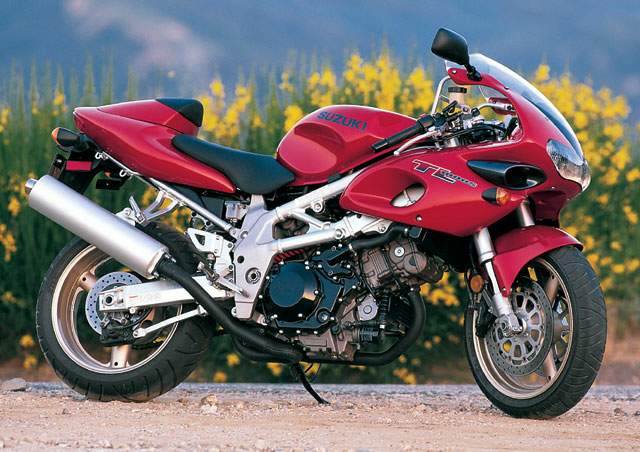Suzuki TL1000S

|
Make Model |
Suzuki TL1000S |
|
Year |
1999 - 00 |
|
Engine |
Four stroke, 90°-V-twin,
DOHC, 4 valves per cylinder |
|
Capacity |
996 cc / 60.8 cu-in |
|
Bore x Stroke |
98 x 66 mm |
|
Cooling System |
Liquid cooled |
|
Compression Ratio |
11.3:1 |
|
Lubrication |
Wet sump |
|
Induction |
2 x 52 mm Mikuni Denso EFI |
|
Ignition |
Digital transistorized |
|
Spark Plug |
NGK, CR9EK |
|
Starting |
Electric |
|
Max Power |
91.1 kW / 125 hp @ 8500 rpm |
|
Max Power Rear Tyre |
84.8 kW / 113.7 hp @ 8500 rpm |
|
Max Torque |
103 Nm / 10.5
kgf-m / 75.9 lb-ft @ 8000 rpm |
|
Clutch |
Wet, multiple discs, cable operated |
|
Transmission |
6 Speed |
|
Final Drive |
Chain |
|
Frame |
Aluminium, trellis frame |
|
Front Suspension |
43 mm Inverted telescopic
fork, coil
spring, fully adjustable spring preload, rebound and compression damping |
|
Front Wheel Travel |
120 mm / 4.7 in |
|
Rear Suspension |
Rotary damping system,
fully adjustable spring preload, compression and rebound damping |
|
Rear Wheel Travel |
128 mm / 5.0 in |
|
Front Brakes |
2 x 320mm Discs, 4 piston calipers |
|
Rear Brakes |
Single 220 mm disc, 2
piston caliper |
|
Front Tyre |
120/70-17 |
|
Rear Tyre |
180/60-17 |
|
Dimensions |
Length 2065 mm / 81.3 in
Width 715 mm / 28.1 in
Height 1175 mm / 46.3 in |
|
Wheelbase |
1415 mm / 55.7 in |
|
Seat Height |
835 mm / 32.9 in |
|
Ground Clearance |
140 mm / 5.5 in |
|
Dry Weight |
191 kg / 421 lbs |
|
Wet Weight |
211 kg / 463 lbs |
|
Fuel Capacity |
17 Litres / 4.4
US gal / 3.7 Imp gal |
|
Consumption Average |
6.2 L/100 km / 16.1 km/l / 37.9 US mpg
/ 45.5 Imp mpg |
|
Braking 60 km/h - 0 |
12.9
m / 42.3 ft |
|
Braking 100 km/h - 0 |
37.9 m / 124.3 ft |
|
Standing
¼ Mile |
10.9
sec / 208.4 km/h / 129.5 mph |
|
Top Speed |
257.8
km/h / 160.2 mph |
|
Road Tests |
Motoplus 1997
Motosprint 1997 |

Road Test
The Forgotten Sporting Twin
It's a tough world out there in sportybike-land. In the time it takes for a
rumor or spy shot of a supposedly quicker, tricker and faster future model to
get published, your latest and greatest can quickly become relegated to
yesterday's news. Even if its capabilities are right up there with the best, all
it takes is the introduction of a flashier model with the promise of superior
performance to push the previous bike into the shadows. Especially if the newer
model comes from the same company and is trumpeted as a "racier" version of the
original.
Such is the case with Suzuki's TL1000S. The all-new V-twin sportbike turned
heads in '97 with its 113-horsepower, fuel-injected powerplant and aluminum
trellis-style chassis. And its outright performance was a match for the
competition at anything up to a ten-tenths, racetrack-scratching pace.
Twin-cylinder sportbikes were all the rage and many of us were expecting the
dawn of a new era in motorcycling, with narrow, lithe V-twins replacing the
comparatively bulky in-line four as the dominant sporting-engine configuration.
Overlooked in all the excitement was a sportbike that was solid and capable in
all respects. Sure, the R-model boasted a twin-spar aluminum frame and a hot-rodded
motor-but it was also wider in the waistline and picked up 20-odd pounds in the
transition. Was all this really worth an extra $500?
But once news of the TL-S's racier brother-the TL1000R-began to surface,
everyone soon forgot about the S-model. With visions of a world-beating, V-twin
sportbike dancing in their heads, many riders decided to stand pat and wait
until the R-model's release. A somewhat sensationalized claim of a handling
problem over in Europe, which forced a worldwide recall of S-models for
retrofitment of a steering damper in order to quell a reputed tankslapping
tendency (we never encountered this problem), definitely tainted the TL1000S as
well.
The TL1000S's larger front fairing offers much better wind protection than the
R-model's aerodynamically slanted windscreen. The mirrors offer a decent
rearward view.Not all riders like to be accordioned into a racer crouch, and the
TL-S's ergonomics straddles the line between hard-core sport and sport-touring
quite nicely. Without all the aerodynamic concerns that come with building an
all-out sportbike, the S-model's fairing provides decent wind protection, unlike
the TL-R's radically canted windscreen. And with electronic fuel injection, cold
morning starts are a breeze. Simply nudge the bar-mounted "fast-idle" lever (it
can't really be called a choke lever since it doesn't enrich the fuel mixture),
warm it up for about 30 seconds and you're on your way.
One of our biggest gripes with the '97 TL1000S was its dismal fuel economy. We
consistently averaged approximately 30 mpg during hard riding and were forced to
refuel every 120 miles lest we end up pushing. Strangely, Suzuki isn't claiming
any changes to the fuel-delivery maps on the '99 TL-S, yet we averaged about 33
mpg this time around. While this is not a huge improvement, it is a gain
nonetheless. We did notice an increased tendency to surge a little at
light-throttle (cruise) settings around town, which may be indicative of leaner
fuel-mixture mapping.
Riding the TL-S on city streets reveals two major changes since we last tested
this model. One is a slight alteration to the clutch's back-torque limiting
ramp, and the addition of a sixth clutch spring. This significantly smooths out
the TL's previous grabbiness during aggressive launches. The other is an
unfortunate side effect of the steering damper. Although it may provide
additional stability during spirited canyon sorties, the nonadjustable damper
also causes the steering to be somewhat truckish at slower speeds. Maneuvering
through traffic and tight confines is more of a chore. And while it's not
lethargic by any means, steering response at higher velocities has been slowed,
requiring a bit more muscle for those quick-flick turn entries.

One of the changes for '99 to the TL1000S is tighter
clearance on the main bearing journals, reportedly to quell mechanical noises
that are concealed by bodywork on the TL1000R.Get the TL out among those
undulating environs where quick turn entries are the name of the game, however,
and its rider-friendly chassis and strong motor have a chance to shine. Although
the steering requires more effort to initiate a turn, its overall manners are
dead neutral at all lean angles with the stock Metzeler rubber. Ground clearance
is abundant, so if you're scraping the nonfeeler-equipped pegs you're probably
riding a bit too fast for the street.
The TL-S's 996cc, V-twin mill reminds us why we liked its overall performance
traits back in '97. While it may not quite pack the midrange torque of some of
its competition, the motor is clearly superior to the R-model in this category;
this, combined with its revvy nature and strong top-end punch, makes
wheelie-prone corner exits a breeze. And in cornering scenarios where most
in-line four sportbikes are trying to spin the rear tire, the TL's smooth V-twin
power pulses let the rider concentrate on subjects other than traction control.
The abrupt on/off throttle transition of the Suzuki's fuel injection is still
present though, so it's best to get your drive started as early and smoothly as
possible.
Although not as impressive-looking as the TL1000R's twin-spar chassis, the
TL1000S's trellis-style, oval-tube aluminum frame is more than up to the task of
offering responsive handling while keeping things under control.It may not look
as stout as the TL-R's twin-spar chassis but the S-model's trellis-style
oval-tube, frame is more than up to the task handlingwise, and it's far slimmer
between the rider's knees than the R-model's rather bulky feel. Along with the
aforementioned hospitable steering manners, the TL1000S's suspension does a very
good job of absorbing the majority of pavement irregularities you're likely to
encounter. Only at a very aggressive pace do any shortcomings appear: mainly
softish spring rates that let the suspension nearly bottom-out in midcorner
bumps, overpowering the rebound damping and causing the TL to weave a bit in
protest. Nothing serious, but it does get your attention.
In this technological age of flash and speed, it's all too easy to overlook the
good sportbikes that don't make a spectacle of themselves. The Suzuki TL1000S
has always been a solid performer. It may have been forced to live in the TL-R's
shadow but for those looking for a useful alternative to the all-out V-twin
sportbikes currently making the rounds, at $8999, the Suzuki TL1000S remains a
sensible choice.
The Suzuki TL1000S's suspension takes a fair bit of dialing in before you can
get things right, and even then it leaves a little to be desired when the going
gets rough. Jim Lindemann has been marketing a Penske replacement shock kit for
the past year or so, and after experiencing his suspension magic on various
bikes in the past, we decided to give it a try. The Lindemann kit replaces the
stock rotary damper unit with a conventional, fully adjustable Penske shock
absorber, sans spring. One of our complaints with the TL-S was overly soft
spring rates; Lindemann has provided a choice of two springs with higher rates
to replace the spring on the stocker's separate unit.
Replacing the spring was a chore, however. The spring unit is packed tightly
into the right side, and requires some maneuvering to remove. You then need to
grind off the peened-over shock shaft inside the clevis in order to loosen the
bottom locknut so the accessory spring can be installed. (Or you can simply send
your spring unit to Lindemann and have it converted for a small fee.) Once all
the components are mounted (including the frame support block that fits in the
space previously occupied by the rotary damper), dial-in is a snap. You'll need
a very small Allen wrench to make rebound-damping adjustments on the shock,
however.
Overall suspension action with the Lindemann kit was greatly improved. Damping
was much more consistent across the suspension stroke, with a more supple
movement over smaller ripples, while large midcorner bumps failed to upset the
chassis. As a result, traction in the gnarlier corners was greatly enhanced,
increasing corner speeds.
At $975, the Lindemann kit isn't exactly cheap, but for those looking to improve
their TL1000S's handling to a point far beyond the stocker's capabilities, it's
a sound investment.
Source
Sport Rider
|
